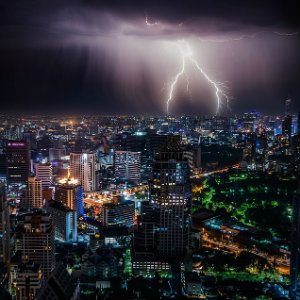After weeks of oppressive heat, most of New York has experienced heavy thunderstorms. While many welcome this change, hoping that it will bring cooler temperatures, the Department of Buildings (DOB) has released a list of precautionary measures that anyone who is in charge of an outdoor working environment should take in order to prevent a workplace accident.
The Measures Suggested
It may seem like a little rain couldn’t do much harm but that couldn’t be further from the truth. In order to keep New York workers and citizens safe, the DOB is recommending the following:
- Any loose materials on the job site should either be tied down or brought to an indoor location.
- All electrical equipment should be covered and kept dry.
- All scaffolding should be either taken down or secured and all loose materials removed from the structure.
- All fences should be braced.
- If winds are expected to reach more than 30 mph or greater, all cranes should be lowered to the ground and secured.
- All other hoisting mechanisms should be lowered and secured if winds reach 35 mph or more.
In their statement, the department noted that when storms are expected they will be performing random site inspections. Anyone who fails to take the proper precautions may have a stop-work order placed or a violation issued.
Stop Work Orders Already Increased
Just this past June, the DOB announced that the number of stop work orders given in 2016 for the first half of the year had increased almost 25% from the same time period of 2015. A stop work order is typically given when the working conditions on a job site are unsafe and are likely to result in the serious injury or death of an employee.
The work orders may be either partial or full. With a partial stop work order, certain parts of the job site are shut down until the safety issues have been corrected. With a full stop work order, the entire job site must be shut down and the only work allowed is to correct the safety violation.
Why Is The DOB Cracking Down?
The construction industry in New York is booming but with the increase in projects, the state has also seen a significant increase in accidents and injuries involving workers. One accident in particular, which took place in Lower Manhattan, caused many city officials, including the mayor, to take notice of potential safety issues after a crane collapsed, killing one man and injuring others. In addition to the toll it took on human lives, the accident also caused structural damage to several buildings, created gas leaks, and damaged the street for nearly two blocks.
Officials are hoping that by making it difficult for companies to continue working until they focus on employee safety, they will prevent accidents, injuries, and deaths. For those who choose to ignore citations, fines, and stop-work orders, it has been made clear that the state will prosecute them to the fullest extent of the law should an injury or death occur. In fact, just recently a contractor was found guilty of manslaughter by a judge after a worker died when the trench he was working in collapsed. At trial, it was revealed that OSHA had repeatedly told the contractor to stop work because the trench was not properly fortified.
What Should I Do If I Was Injured Due To A Safety Violation?
If you suspect that your workplace accident and injury was the result of your employer failing to follow safety standards, there are several steps you should take to protect yourself after receiving medical attention:
- Contact OSHA: Report any safety issues to OSHA. They will send a representative to inspect the job site.
- Contact An Attorney: An attorney can assist you throughout the workers’ compensation application process and, if need be, an appeals process. They can also help you determine if you may be eligible for a third party personal injury lawsuit.
- Take Pictures: It’s always good to have visual proof of the issue you suspect caused your accident.
- File A Workers’ Compensation Claim: Regardless of who was at fault for your injuries, workers’ compensation can be claimed.
Why Was My Claim Denied?
If you have already filed a workers’ compensation claim and it has been denied, the denial is likely due to one of the following common reasons:
- The claim was not filed in time.
- Your employer has chosen to dispute the claim.
- The insurance company says your injury isn’t severe enough to warrant a workers’ compensation claim.
- Insufficient documentation has been provided.
The denial letter will give the reason as to why the claim was denied. To learn about the ways in which you can appeal that denial, contact a workers’ compensation attorney as soon as possible.


